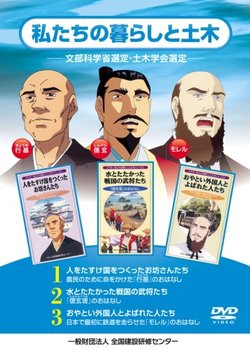
Watashitachi no Kurashi to Doboku
私たちの暮らしと土木
The 3-part series commissioned by Japan Construction Training Center for educational purposes (to elementary schools originally) shows how civil engineering has developed Japan into the country it is now. Part 1: Takes place in the Nara period and covers Chinese Buddhist monks which came to Japan and taught the people Buddhism and how to construct and fix bridges and pods to improve the lives of farmers suffering from drought and taxes in what is currently the Hyoujo Prefecture. Part 2: Takes place in the Sengoku period and covers Takeda Shingen and how the Kai Province was always plagued by the violent river rains dues to the mountain region surrounding them to them causing the Kofu Basin to flood. He funneled man-power into developing a system of flood control using stone embankments and planting tree lines. The civil engineering project is also the foundation for the Roushigumi which later became the Shinsengumi in the Edo period. Part 3: Takes place in the Edo period and covers the Meiji government wantin to catch up with the rest of the world's technology and hired many foreigners to implement the success of the Western world's industrial revolution. "Contract foreigners" (oyatoi gaikokujin) brought knowledge of: lighthouses, railways, ports, water supplies, improved flood control, and education. The railways specifically were handled by the British railway engineer Edmund Morel who was a mere 28 year old. The project was completed in 2 years connecting Tokyo to Yokohama in 1872 as Japan's first railroad and first two railroad stations. Unfortunately Morel had tuberculosis and died in right before the projected completed but he advised many Japanese scholars and engineers on railway production in his own home til his dead which lead to the boom of ever-so-famous-and-successful Japanese railway system.